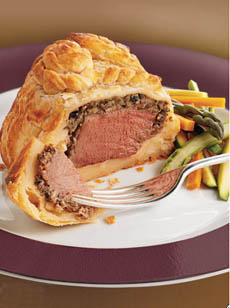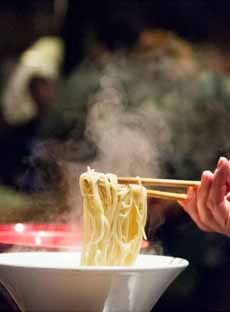FOOD HOLIDAY: The History Of Chopsticks For National Chopsticks Day
|
January 6th is National Chopsticks Day, a reason to enjoy an Asian meal or two. We’re making homemade dumplings with this easy video recipe. As we contemplate the history of chopsticks, the eating utensil of choice in Asia, let’s compare them to the history of the forks, knives, and spoons used at tables in the West. This information is adapted from a wonderful exhibit, The History Of Eating Utensils, at the California Academy Of Sciences, much of which is available online. No matter what the country of origin, utensils were historically made in costly materials for the wealthy, and humble materials for everyone else. Table utensils have been made from metals (gold, silver, and pewter—and today, stainless steel), bone, crystal, horn, ivory, lacquered wood, porcelain, pottery, shell, and wood. And today, plastic. Also below: the history of forks, spoons, and knives. Chopsticks were developed about 5,000 years ago in China. Long before chopsticks were used for eating, they were used for cooking—reaching into deep pots. Historians believe that people cooked their food in large pots which retained heat well. Hasty eaters then broke twigs off trees to retrieve the food. The twigs evolved into chopsticks. It wasn’t until a population boom in the 4th century that chopsticks surpassed spoons as the utensil of choice in China. By 400 B.C.E., a large and growing population taxed the fuel supply. Food was chopped into small pieces that cooked rapidly, requiring less fuel. Small pieces also meant that knives were not needed at the dinner table—a cost savings, among other benefits. By 500 C.E., chopsticks spread to present-day Vietnam, Korea, and Japan. Chinese chopsticks, called kuai-zi (“quick little fellows”), are 9 to 10 inches long and rectangular with a blunt end. The English word “chopstick” was likely derived from the Chinese Pidgin English words “chop chop,” meaning fast. In Japan, chopsticks are called hashi (the word means “bridge”). The earliest chopsticks used for eating looked like tweezers; they were made from one piece of bamboo that was joined at the top. Known as tong chopsticks, today they are used as “training chopsticks” for children. See them here. Japanese chopsticks differ in design from Chinese chopsticks: They are rounded and have a pointed end. They are also shorter—8 inches. |
|
|
|
Proper Use Of Chopsticks Forks trace their origins back to the time of the Greeks. The original forks were large service forks with two tines, to aid in the carving and serving of meat. That design survives today in carving forks. By the seventh century C.E., smaller forks for individual use appeared in royal courts of the Middle East. They spread to use by the wealthy in Byzantine Empire*; in the 11th century, a Byzantine wife of a Doge of Venice brought forks to Italy. The Italians, however, were slow to adopt their use. Forks were not widely adopted until the 16th century. In 1533, forks were brought from Italy to France by Catherine de Medici, the bride of the future King Henry II. The French, too, were slow to accept forks, thinking them to be an affectation. An Englishman named Thomas Coryate brought the first forks to England from Italy, in 1608. The English ridiculed forks as being effeminate and unnecessary. “Why should a person need a fork when God had given him hands?” was a refrain. Yes, it wasn’t all that long ago that even “civilized” people ate with their hands, spoons, impaled their food on knives, or used bread to scoop it up. But by the mid-1600s, eating with forks was considered fashionable among wealthy British. Early table forks were modeled after kitchen forks with two tines that ensured that meat would not twist while being cut. However, small pieces of food regularly fell through the tines or slipped off easily. In late 17th century France, larger forks with four curved tines were developed to solve the problem. The curved tines—used today—served as a scoop so people did not have to constantly switch to a spoon while eating. And forks were more efficient for spearing food than the knife. But the fork did not become common in northern Europe until the 18th century and was not common in North America until the 19th century. See the beautiful forks in the California Academy of Sciences exhibit. *The Byzantine Empire, which existed from approximately 330 C.E. to 1453 C.E., comprised the predominantly Greek-speaking continuation of the Roman Empire. Its capital city was Constantinople (modern-day Istanbul), originally known as Byzantium. During most of its existence, the empire was the most powerful economic, cultural, and military force in Europe. |
||
 [3] Imagine eating without a fork. Yet, it was ridiculed and rejected by the British, French, and Italians (photo © Allen Bros).
|
THE HISTORY OF SPOONS Spoons are the oldest eating utensils, in use since Paleolithic times. These prehistoric peoples—the first modern humans—probably used shells or chips of wood as eating and serving utensils. In fact, both the Greek and Latin words for spoon are derived from cochlea, a spiral-shaped snail shell (that also gives its name to the spiral-shaped cavity in the inner ear), suggesting that shells were commonly used as spoons in Southern Europe. The Anglo-Saxon word spon, the predecessor of the spoon, refers to a chip or splinter of wood. In the first century C.E., the Romans designed two types of spoons: Knives have been used as weapons, tools, and eating utensils since prehistoric times. Only fairly recently were they adapted for table use. In the Middle Ages in Europe, hosts did not provide cutlery for their guests; most people carried their knives in sheaths attached to their belts. These knives were narrow and their sharply pointed ends were used to spear food and then raise it to the mouth. The multi-purpose nature of the knife—weapon and eating utensil—always posed a threat of danger at the dinner table. Once forks began to gain popular acceptance, there was no longer any need for a pointed tip at the end of a dinner knife. In 1669, King Louis XIV of France decreed all pointed knives on the street or at the dinner table illegal, and he had all knife points ground down to reduce violence. That’s why today we have blunt-tipped “table knives” and separate “steak knives.” At the beginning of the 18th century, very few forks were imported to America. However, knives were imported and their tips became progressively blunter. Because Americans had very few forks and no longer had sharp-tipped knives, they had to use spoons in lieu of forks. They would use the spoon to steady food as they cut and then switch the spoon to the opposite hand in order to scoop up food to eat. |
|
|
This distinctly American style of eating continued even after forks became commonplace in the United States. CHECK OUT WHAT’S HAPPENING ON OUR HOME PAGE, THENIBBLE.COM. |
||





